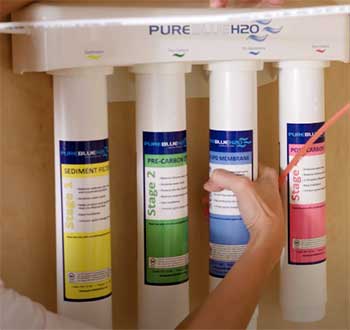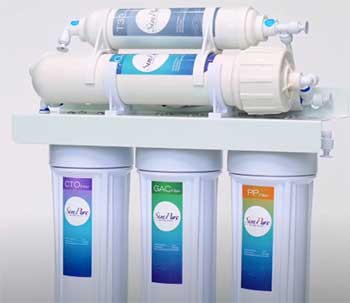Reverse osmosis (RO), a popular and effective water purification method, is a much-lauded technology for removing a vast majority of harmful contaminants. Among the plethora of options available on the market, 4 stage and 5 stage RO systems are the most commonly employed.
But what’s the real difference between these two? Which one is the better investment for your household?
In this article, we’ll dissect and compare these two powerful allies in your quest for clean, pure water.
A Brief Comparison Table
| Feature | 4 Stage RO System | 5 Stage RO System |
| Number of Stages | 4 | 5 |
| Filtration | Sediment Pre-filter, Carbon Filter, RO Membrane, Post Carbon Filter | Sediment Pre-filter, Carbon Filter, Second Carbon Filter, RO Membrane, Post Carbon Filter |
| System Efficiency | Excellent | Superior (given high contaminant levels) |
| Maintenance | Less frequent | Slightly more frequent (due to additional filter) |
| RO Membrane Lifespan | Standard | Potentially longer (due to added protection from second carbon filter) |
| Space Requirements | Less | More (due to additional filter) |
Exploring 4 Stage Reverse Osmosis Systems

A 4 stage RO system is a solid investment, typically comprising of:
- Sediment Pre-filter: Removes dust, dirt, and sediment.
- Carbon Filter: Eliminates chlorine and other contaminants that affect the taste and odor of water.
- RO Membrane: The core of the system, it removes up to 99% of total dissolved solids (TDS).
- Post Carbon Filter: Gives a final polish to your water, ensuring a refreshing taste.
Advantages of 4 Stage RO Systems
A 4 stage RO system provides excellent performance for smaller households or individuals who primarily use their water for drinking and cooking. The four comprehensive stages effectively filter the water, removing harmful impurities and improving the taste and odor.
It’s a compact, easy-to-maintain system with fewer parts that can malfunction.
Delving into 5 Stage Reverse Osmosis Systems
In comparison, a 5 stage RO system includes an extra stage of purification. It generally consists of:

- Sediment Pre-filter
- Carbon Filter
- Second Carbon Filter: Further removes chlorine and other taste/odor affecting contaminants.
- RO Membrane
- Post Carbon Filter
Advantages of 5 Stage RO Systems
A 5 stage RO system provides an additional layer of protection, courtesy of the second carbon filter.
This ensures that any potential remnants of chlorine or other taste and odor contaminants are completely eradicated.
It’s a robust solution for larger households, offices, or individuals with a higher consumption of water.
Key Differences Between 4 Stage and 5 Stage Reverse Osmosis Systems
When comparing 4 stage and 5 stage reverse osmosis (RO) systems, the fundamental difference lies in the number of filtration stages, affecting the purity of water and system’s overall performance.
However, this additional stage in the 5 stage system doesn’t automatically make it superior. Your specific needs, water quality, and consumption patterns play crucial roles in deciding which system is ideal for you.
- Stage Composition
Both 4 stage and 5 stage RO systems start with the same three fundamental filtration stages: the sediment pre-filter, the carbon filter, and the RO membrane.
The 4 stage RO system ends with a post-carbon filter, also known as a polishing filter. This filter gives a final touch to the water, improving its taste by removing any lingering odors or tastes.
On the other hand, the 5 stage RO system adds an extra carbon filter between the sediment filter and the RO membrane.
This second carbon filter gives the system an added layer of protection against chlorine and other contaminants that affect the taste and odor of water, ensuring that they are completely eradicated before the water even reaches the RO membrane.
- System Efficiency
System efficiency varies between 4 stage and 5 stage RO systems. Since a 5 stage system includes an extra filtration step, it tends to produce cleaner and purer water. However, it’s important to note that this doesn’t automatically equate to better efficiency.
If your water source already has low levels of contaminants, you may not notice a significant difference in water quality between the two systems.
Conversely, if your water supply has high levels of chlorine or other taste and odor contaminants, the 5 stage system can offer a noticeable improvement.
- Maintenance
Maintenance considerations can also affect your decision. A 4 stage RO system generally requires less maintenance due to fewer filter replacements.
But the difference in maintenance needs between the two isn’t necessarily significant.
In a 5 stage system, the second carbon filter protects the RO membrane from potential chlorine damage, prolonging its lifespan. This means you may end up replacing the less expensive carbon filters more frequently but save money on the costlier RO membrane in the long run.
- Installation and Space Considerations
Both 4 stage and 5 stage systems have similar installation procedures. However, 5 stage systems can be slightly larger due to the additional filter, so if space under your sink is limited, a 4 stage system might be a better fit.
Choosing between a 4 stage and 5 stage RO system comes down to your individual needs. If your water source is heavily chlorinated, a 5 stage system might be the better option.
Conversely, if your water is already fairly clean and you’re primarily looking to improve taste and remove simple contaminants, a 4 stage system should suffice.
Frequently Asked Questions (FAQ)
A 5 stage RO system adds an additional carbon filter stage to the purification process, offering a further reduction of chlorine and other taste or odor contaminants. It ensures an even cleaner, purer output of water.
Reverse osmosis is a water purification process, while a 5 stage system is a type of reverse osmosis system that uses five stages of filtration to purify water.
The number of stages needed depends on your water source and the quality of water you desire. If your water supply has high levels of contaminants or is heavily chlorinated, a 5 stage system may be preferable. Otherwise, a 4 stage system can efficiently provide clean and tasty water.
A 4 stage RO system is a type of reverse osmosis system that employs four stages of filtration – a sediment pre-filter, a carbon filter, an RO membrane, and a post-carbon filter, to purify your water.
Conclusion
Whether you choose a 4 stage or 5 stage reverse osmosis system, both offer a compelling path to healthier, cleaner, and tastier water. Always assess your individual needs and the quality of your water source before deciding on the most suitable system.
Happy hydrating!
